|
Dyno results discussed near the botton of the page.
....Does a dyno test
hurt your bike? There are any different opinions on this one. One
post indicated never reuse the back tire on the highway after it has been on a
dyno. Hum, thousands of bikes are out there on dynoed rear tires.
Remember the bike is run up to redline at least twice each dyno test, so the
engine is working all out to turn a heavy weighted drum on which the rear wheel
is sitting to see how much torque in ft-lb, can be applied by the engine at any
given rpm. Yes, a dyno run is not as good as your power train taking a
"nap" but neither is the kind of hard road riding I have been doing
with the FZ compared to riding with the cruisers or "stabled."
|
[] IowaZ Sitemap []
Send Email [] FZ1
Owner's Association [] IowaZ
Vmax Sitemap []
IowaZ
V65 Magna Page []
Use the FZ1 Sitemap to navigate all of the FZ pages.
Yamaha FZ1
Explanation of Torque and Horsepower
FZ1 Dyno Results
and other information on performance.
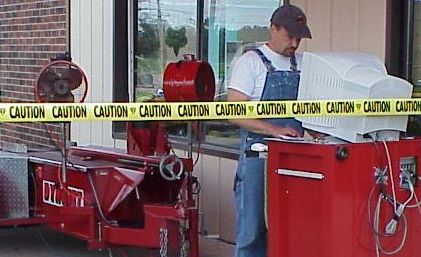
Rob will give you a print out of the torque,
horsepower curves and
give you an opinion on the present state of the engine, exhaust, fuel
systems,
and some helpful hints to make the bike run better or to increase power.
Input, information, posts regarding FZ dyno runs:
....If you have have made an FZ dyno
run and would like to list the results for others use, post to me, iowaz@swbell.net
Dyno Results and Posts:
....IowaZ FZ and two other FZ's on Rob's dyno,
all three 120+ hp, 70+ ft-lb. R1's are 134-136 on this dyno. My Max was
112 & 76, my V65 98 & 65.
....Jean's FZ from Austrailia---- 125 hp, 72 ft-lb. R-1's are 130 on the
same dyno, and some FZ's are approaching that value. ??Are U.S.FZ's
restricted??
.....jmness's FZ----Don't know about full system and jet kit but I got 120.9
HP yesterday on the dyno and then put on a Yosh RS-3 slip-on and ended up with
a better sound and 123.4 HP. No holes in the power band, carburetion was right
on.
....Rabett's FZ---I posted a photo of the dyno run done on my bike a week or two ago. HP was up around 128, torque at 74. Who knows how accurate these are.
....modette observed---A stock FZ1 made if I recall right at 119HP
Some Performance Data on
various bikes:
Top Speeds:
....192mph, Suzuki Hayabusa (Oct 2001 Sport Rider)
....190mph, Kawasaki ZX-12R (Oct 2001 Sport Rider)
....179mph, Suzuki GSX-R1000 (Nov 2001 Sport Rider)
....157mph, Suzuki GSX-R600 (Nov 2001 Sport Rider)
....157mph, Honda CBR600F4i (Nov 2001 Sport Rider)
....157mph, Yamaha YZF-R6 (Nov 2001 Sport Rider)
....153mph, Yamaha FZ1 (Mag
Reviews, Z's Sigma calc.)
....144mph, Yamaha Vmax (introduced 1985, Z's best guess)
....142mph, Honda 1985 V65 Magna (Z's best guess)
.....
Rear Wheel Hp
....159.8hp, Kawasaki ZX-12R (Oct 2001 Sport Rider)
....158.0hp, Suzuki Hayabusa (Oct 2001 Sport Rider)
....143.9hp, Suzuki GSX-R1000 (Nov 2001 Sport Rider)
....129.2hp, Honda CBR929RR (Nov 2001 Sport Rider)
....128.4hp, Yamaha YZF-R1 (Nov 2001 Sport Rider)
....120+hp, Yamaha FZ1 (Mag
Reviews, Z's dyno run)
....108+hp, Yamaha Vmax (introduced 1985, Z's dyno run)
....101+hp, Suzuki Bandit 1200S (Oct 2000, Motorcyclist)
....100.1hp, Suzuki GSX-R600 (Nov 2001 Sport Rider)
.....98.6hp, Honda 1985 V65 Magna (Z's dyno run)
.....98.4hp, Honda CBR600F4i (Nov 2001 Sport Rider)
.....96.9hp, Yamaha YZF-R6 (Nov 2001 Sport Rider)
.....81.6hp, Moto Guzzi V11 Sport (Oct 2000, Motorcyclist)
Torque
...100.1ft-lb, Susuke Haybusa (Oct 2001 Sport Rider)
....91.4ft-lb, Kawasaki ZX-12R (Oct 2001 Sport Rider)
....77+ft-lb, Yamaha Vmax (introduced 1985, Z's dyno run)
....75.1ft-lb, Suzuki GSX-R1000 (Nov 2001 Sport Rider)
....71.8ft-lb, Suzuki Bandit 1200S (Oct 2000, Motorcyclist)
....70.3ft-lb, Yamaha YZF-R1 (Nov 2001 Sport Rider)
....70+ft-lb, Yamaha FZ1 (Mag
Review, Z's dyno run)
....68+ft-lb, Honda V65 1985 Magna (Z's dyno run)
....67.6ft-lb, Honda CBR929RR (Nov 2001 Sport Rider)
....65.0ft-lb, Moto Guzzi V11 Sport (Oct 2000, Motorcyclist)
....45.2ft-lb, Suzuki GSX-R600 (Nov 2001 Sport Rider)
....43.6, Honda CBR600F4i (Nov 2001 Sport Rider)
....42.0, Yamaha YZF-R6
IowaZ Simplified Analogy of
Torque, Horsepower and what it means on the Street.....
....In another life I once taught physics and physical science and
approached this topic from a lab standpoint. Now as the most basic of
shade tree mechanics, my interest is understanding torque and horsepower
in an attempt to make order out of all the confusion coming from reading
periodical reviews and various list posts regarding how this bike or that bike
will out perform, out torque, out horsepower the others. So what the
#ell does it all mean??????
Off to Kinderphysics we go.....
We learn new words in Kinderphysics----Force,
Work, Torque, Horsepower.
....For us, Force is energy exerted against matter. We want to move
something. That is pretty much how we can think of force. We want
the engine to generate force which can be applied to rotate the rear tire and
drive us down the road.
....Work is a force applied for "awhile."
A force applied through a unit of
time like a second, minute or hour. The force actually moves an object of
interest, thus a force to move a pound one foot (assuming no friction) is the
foot-pound, or ft-lb. Ft-lb sounds familiar, it is work that sends the FZ
scooting down the road. It is also the turning force we apply to
fasteners when we are wrenching on the FZ. We are interested in just how much force that
little-bitty inline four can apply to the ground through the tire, to propel
us further and faster than all the other "land planes."
.....The word torque in the science of Physics refers to rotary
force that does work turning/spinning a machine. If you run
out of gas and are going to get your FZ off the road you could apply a force
by hand in two different way to move the bike. If you just stand behind and
push, the force is linear or straight line force. But if the tire is
stuck in the mud and linear pushing is not working, you might try to grab and
spin the back wheel forward to get the bike moving. You are actually
trying to rotate the wheel around the axle which in turn will move the bike
forward out of the mud. This rotational force you are applying is
by definition called torque. Now you are a feeble torque producer
at spinning the wheel, but that son of R1 engine is not, nor are most modern
bikes. They can produce a lot of force or torque to spin the rear wheel
and accelerated the bike forward.
....In review, torque is a rather simple term to visualize. It is force applied to
rotate something like a pulley, a wheel, an axle. Torque is a force, thus it is
measured in ft-lb. The amount of rotary force or torque that can be
applied at any point in time is of interest to cyclist as if all things being
equal it will give a feel of how "fast" a cycle can be accelerated
forward.
.....Ask yourself which weight lifter can spin a merry-go-round faster, the
super strong or the 98lb weakling?? That pretty well summarizes the
torque issue. Engines have varying abilities to apply rotation to
their axels, shafts, pulleys, chains, wheels. Engines also produce different levels
of torque at different times, and hold torque levels for varying times.
.....A dynomometer is an instrument or machine that measures torque (ability
to do rotary work). Thus the word "dyno" that is thrown
around in the cycling world. Ft-lb's of torque applied per second can/is
converted into a horsepower value for a specific engine at a specific rpm
level. The ability of an engine to produce rotary power or work
varies within the rpm curve for that engine.
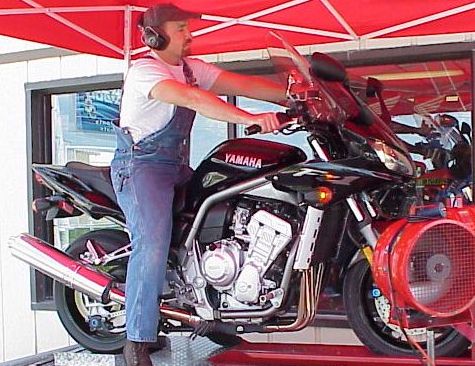
Hey Coach, keep the plays simple for us, will
you!!
..... You have just made a dyno run with your bike and are looking at the
graph but what does it mean. An oversimplified but effective
visualization is to look at the top levels of the torque curve as the
point where the big strong weight lifter can really push or accelerate you
down the road the quickest. The low points of the curve have the 98
pounder pushing. Or in the case of some bikes, a 98 pounder is always
pushing.
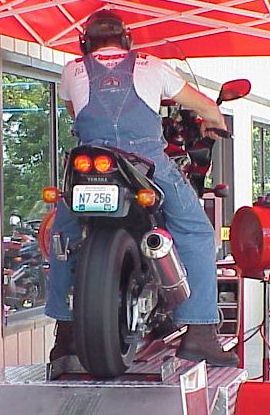
....Another thing of interest is that a torque curve which is high at the
higher rpm's means that we have a big strong weight lifter pushing but he is
also a major sprinter, so he can respond very quickly to accelerate the #ell
out of the bike while the bike is already at high speeds. That kind of
tells why a bike like the FZ or Max can be running along at 90-120 and still
give the seat-of-the-pants the feel of dropping over the top of a roller
coaster when the throttle is hit.
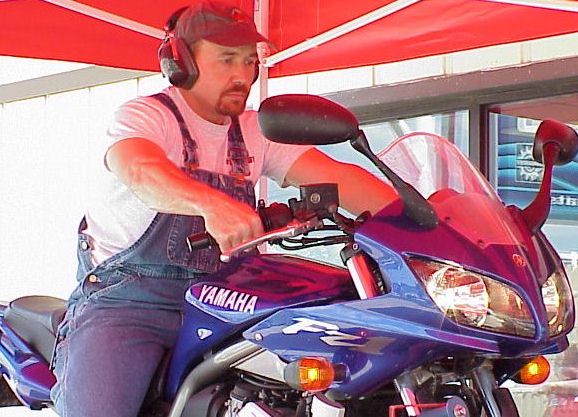
....A cycle rider is basically interested in the torque of his bike engine or how much force the motor can apply to the road through the rotation of the various parts of the cycle drive train, as this is what he feel and uses to accelerate to a higher speed. He is interested in how big and strong the weight lifter is and how quick the lifter can apply his power. We like big explosive lifters. But a word of caution in this analogy, size does not always matter in the torque game, as little lifters can be much stronger and more explosive than big boys. It all depends on genetics and training. Did coach mention to us, R1 the "daddy" of the FZ engine, or Venture the uncle of the Max V4? And what about the training at the race track for the FZ's daddy and on the highway for the uncle of Mr. Max. Then again, you can see what can happen with children. You can be a genetic stud like the Vmax or you can be a drooler like the Royal Star. Thank heaven thoroughbred's like the R1 almost always have race level offspring, or we can be sure some spandex boy at Damaha would detune it to drooler class because, "That is what the want." Ya, sure!
....Another thing the average
street rider must consider when bragging about the torque or power of his
"athlete" is that, often the big slow boys can produce the big
torque and acceleration off the line at low/slow rpms. The lineman can
knock the crap out of the back in front of him, but let the back get into open
field where his power and speed will produce the "torque" of
acceleration and the lineman has no chance of catching up. The lineman
may be able to run nearly the same top speed at the start but will never catch up because
upon every acceleration point the big boy will fall farther and farther behind
in the race to the goal. Some guys are muscle boys and have it
all. The linebackers are big, strong, agile and fast. So are real
and modern muscle bikes capable of high rpm's with big long, powerful torque
and horsepower curves.
....Actual work output of an engine or horsepower will continue to climb as
the rpms go up as long as the rpm's can be maintained. Once the big guy
is moving it does not take as much force or torque to keep him moving, thus as
the engine spins faster more work is done, or more horsepower output.
Visualize again----torque is the big fast lifter pushing, accelerating
you hard down the road, while horsepower is just the overall work being done
or how fast the big guy is getting down the road. Once he is in motion
at any given speed it does not take as much to keep him motivating along so
his total work or horsepower is going up the faster his big legs rotate.
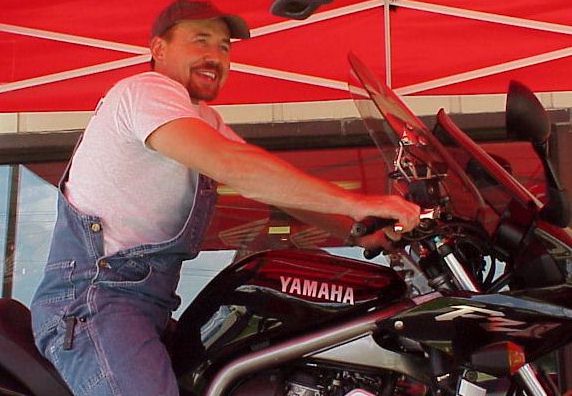
.....Harley's and Rice brand
cruisers tend to produce a lot of torque/force at lower rpm's. Their
riders like that as
they ride relatively slow around town or accelerate from low speeds. For
more aggressive and experienced riders it is better to have high torque at
middle and high rpm's. Most of the street time on bikes like the FZ is
spent at 3-7k rpm's, that is why you read about the mid-range of street
bikes. It is the middle of the rpm range where good torque/force is
desired for street riding. They are the big strong athletes with fantastic sprint
speed who can dart left and right, has power, speed and gears. He is
the linebacker, the stud :) He is the bike that is good from light to
light and at highway roll-ons. He is the bike that can literally do it
all during the street game.
.....The rule for the non-cruiser type but non-racer type, the street
hooligan, is to have a lot of torque in the mid range of the rpm
curve. Most inline four or V-four street riders of bikes, like the old
muscle bikes and standards, and now the Super Standards including the FZ,
keep their rpm's from 3000 to about 7000 during most of their riding
time. It is at these rpm's we want high torque in all gears (a big bad
fast athlete who can dart). It is in this range that the Muscle
Standards dominate the everyday street. The high low-end-torque of the
Hardley/cruiser crowd can not compete off the line with this kind of torque at
high rpms. They often can come off as fast or faster but just run out of
"steam" too soon. Now do not take the low
end torque of a Hardley lightly, as they are torque machines for a short
distant off the line, everything else being equal. Weight, gearing,
engine efficiency, etc. Hardley's can be the real deal at the low
end of the rpm range. So despite my Harley bashing, which is really all
in fun, a good Harley rider, a rider much better than we are, with some
engine work, is a powerful street rider and will probably blow you socks off.
.....For aggressive/fun all round street riding, the rule is to have high torque at the mid-range of the rpm curve and to have the torque or power output continue well into the high rpm's. Thus the Super Standards from any company and the old Muscle Bikes dominate the "streets." Are we biased :)) Actually it is generally the rider and not the bike that is the dominator.
....When you take a look at the FZ torque/hp curves below you will notice that
torque stays high from about 3k to the end of the power band, and horsepower
just keeps climbing. Between 5 and 10+ k rpms the FZ torque (rotary
force) is at its best. Thus the reason why the FZ will just keep
"coming on" until redline. Torque peak seems to be about 70
ft-lb for the FZ. which is in the high range, especially for a 1000 cc street
engine, with the relatively light weight and a horsepower curve that continues
to the end of the rpm's.results.
....There are quite a number of other bikes on the street producing torque in the 80's and 90's stock but most are heavy and cannot turn high rpm's and produce high hp. It would appear that most stock FZ's are right at 120 +/- hp. and 70 +/- ft-lb of torque.
....Three FZ's have been run on this specific dyno with the same relative results: 120+ hp, 70+ torque.
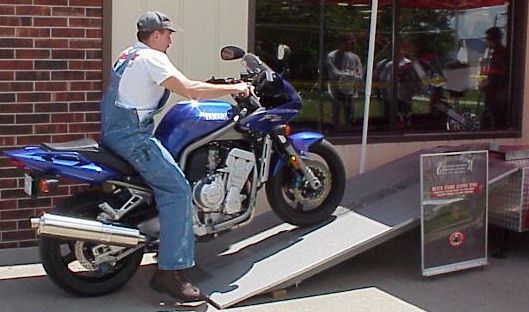
Rob Creighton of Performance
Diagnostics out of Cedar Rapids, Iowa does hundreds of dyno runs on all types
of cycles, all over the midwest and is capable of immediate analysis and
suggestions on tuning. He is a master Harley tuner, as an example being able to
take an 883 Sportster from about 43-45 hp to 93 +/- hp with about $2500 in mods and
time, which is major bang for the buck. http://www.performancediagnostics.com
As with most of us, Rob likes all types of bikes.
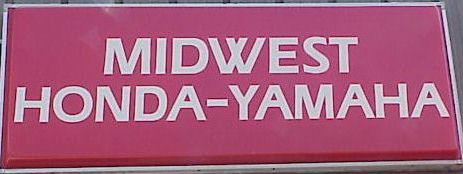
Rich, the owner of Midwest Performance, http://.www.midwestperformacne.com
, good shop/good service. in Keokuk, Iowa, heading out for a test ride on Z'FZ1
and to warm it up for a dyno
run. Midwest Performance brings the dyno to Keokuk at the end of May and June each
year. Lucky for me I latched onto this FZ before Rich had a chance to
ride it :)) Rich is a major cycle rider and knows a good thing!!
He will be on an FZ soon ;)
Yamaha's GYTR Slipon
IowaZ's FZ1 dynorun comparisons:
Horsepower
....Stock exhaust = 120.1 hp
....GYTR slipon = 122.2 hp
Torque
....Stock torque = 70.0 ft-lb
....GYTR slipon = 70.3 ft-lb
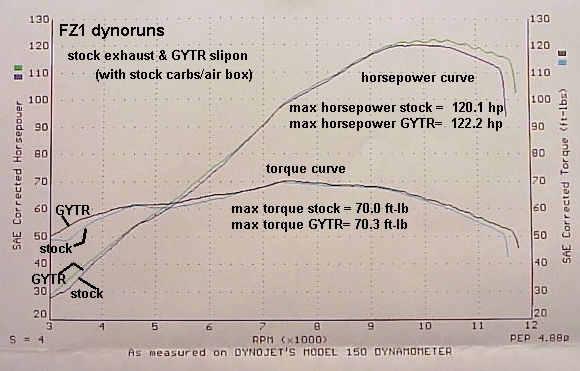
....My "seat of the
pants" performance opinion of the GYTR slipon from Yamaha was good right
from the start. I could feel no low spots, hesitation, problems in any
area of the RPM band. The dynorun backs up the seat of the pants
evaluation of the slipon.
....The dyno run of the GYTR slipon shows improved performance at low to
midrange rpm's and smooths out both the hp and torque curves in the low range.
....At this point in time, I am more than happy with the hp/torque output of
the FZ1 either stock or with the GYTR slipon. It runs perfect from idle
to top end.
....I will be running stock carbs and air box, and not joining the great
tuning wars of rejetting, as this is more than enough "juice" to
racetour and troll for Hardleys ;)
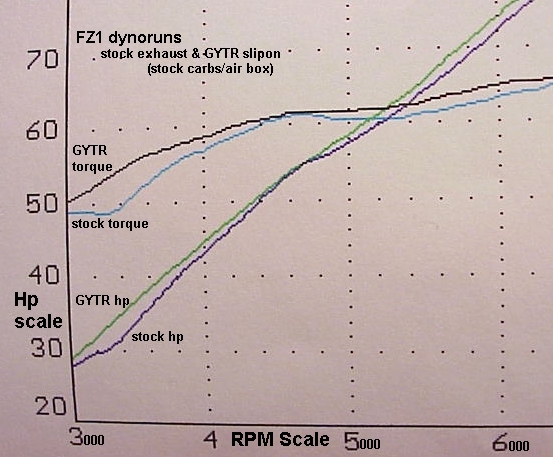
Some Other Posts and Dyno Runs Reported by FZ riders
KSFZ1, Sept 29, 2001
....My first runs bone stock
were 120 hp with 70 ft/lb of
torque.
....I added Ivans Jet Kit and Yosh
TRS Race slip-on exhaust and am getting 132.8
and 74.7 ft/lb. Not bad. I had a dyno run this afternoon. Here are the
results.
SAE Max HP=132.8 @ 10500 rpm SAE Max Torque= 74.7 ft/lb The HP curve looks
like a straight line through 9500 rpms then it rounds off. The Torque curve
looks good too. Nice and fat. The Air/Fuel Ratio looks flat after 5200-5500
rpms Ratio = 13. But at 2800 rpm the AFR is 14 then dips dpwn tp 11.5 at 4000
rpms and comes back up to 13 at around 5200 to 5300 rpms. Looks like I am
running rich in the needle jet circuit.
Feb 2001
Torque and Horsepower
....There's been a certain amount of discussion, in this and other files,
about the concepts of horsepower and torque, how they relate to each other,
and how they apply in terms of automobile performance. I have observed that,
although nearly everyone participating has a passion for automobiles, there is
a huge variance in knowledge. It's clear that a bunch of folks have strong
opinions (about this topic, and other things), but that has generally led to
more heat than light, if you get my drift :-). I've posted a subset of this
note in another string, but felt it deserved to be dealt with as a separate
topic. This is meant to be a primer on the subject, which may lead to serious
discussion that fleshes out this and other subtopics that will inevitably need
to be addressed.
....OK. Here's the deal, in moderately plain english.
....Force, Work and Time
If you have a one pound weight bolted to the floor, and try to lift it with
one pound of force (or 10, or 50 pounds), you will have applied force and
exerted energy, but no work will have been done. If you unbolt the weight, and
apply a force sufficient to lift the weight one foot, then one foot pound of
work will have been done. If that event takes a minute to accomplish, then you
will be doing work at the rate of one foot pound per minute. If it takes one
second to accomplish the task, then work will be done at the rate of 60 foot
pounds per minute, and so on.
....In order to apply these measurements to automobiles and their performance
(whether you're speaking of torque, horsepower, newton meters, watts, or any
other terms), you need to address the three variables of force, work and time.
....Awhile back, a gentleman by the name of Watt (the same gent who did all
that neat stuff with steam engines) made some observations, and concluded that
the average horse of the time could lift a 550 pound weight one foot in one
second, thereby performing work at the rate of 550 foot pounds per second, or
33,000 foot pounds per minute, for an eight hour shift, more or less. He then
published those observations, and stated that 33,000 foot pounds per minute of
work was equivalent to the power of one horse, or, one horsepower.
.]..Everybody else said OK. :-)
....For purposes of this discussion, we need to measure units of force from
rotating objects such as crankshafts, so we'll use terms which define a
*twisting* force, such as foot pounds of torque. A foot pound of torque is the
twisting force necessary to support a one pound weight on a weightless
horizontal bar, one foot from the fulcrum.
....Now, it's important to understand that nobody on the planet ever actually
measures horsepower from a running engine. What we actually measure (on a
dynomometer) is torque, expressed in foot pounds (in the U.S.), and then we
*calculate* actual horsepower by converting the twisting force of torque into
the work units of horsepower.
....Visualize that one pound weight we mentioned, one foot from the fulcrum on
its weightless bar. If we rotate that weight for one full revolution against a
one pound resistance, we have moved it a total of 6.2832 feet (Pi * a two foot
circle), and, incidently, we have done 6.2832 foot pounds of work.
....OK. Remember Watt? He said that 33,000 foot pounds of work per minute was
equivalent to one horsepower. If we divide the 6.2832 foot pounds of work
we've done per revolution of that weight into 33,000 foot pounds, we come up
with the fact that one foot pound of torque at 5252 rpm is equal to 33,000
foot pounds per minute of work, and is the equivalent of one horsepower. If we
only move that weight at the rate of 2626 rpm, it's the equivalent of 1/2
horsepower (16,500 foot pounds per minute), and so on. Therefore, the
following formula applies for calculating horsepower from a torque
measurement:
....Torque * RPM
Horsepower = ------------
5252
This is not a debatable item. It's the way it's done. Period.
....The Case For Torque
Now, what does all this mean in carland?
....First of all, from a driver's perspective, torque, to use the vernacular,
RULES :-). Any given car, in any given gear, will accelerate at a rate that
*exactly* matches its torque curve (allowing for increased air and rolling
resistance as speeds climb). Another way of saying this is that a car will
accelerate hardest at its torque peak in any given gear, and will not
accelerate as hard below that peak, or above it. Torque is the only thing that
a driver feels, and horsepower is just sort of an esoteric measurement in that
context. 300 foot pounds of torque will accelerate you just as hard at 2000
rpm as it would if you were making that torque at 4000 rpm in the same gear,
yet, per the formula, the horsepower would be *double* at 4000 rpm. Therefore,
horsepower isn't particularly meaningful from a driver's perspective, and the
two numbers only get friendly at 5252 rpm, where horsepower and torque always
come out the same.
....In contrast to a torque curve (and the matching pushback into your seat),
horsepower rises rapidly with rpm, especially when torque values are also
climbing. Horsepower will continue to climb, however, until well past the
torque peak, and will continue to rise as engine speed climbs, until the
torque curve really begins to plummet, faster than engine rpm is rising.
However, as I said, horsepower has nothing to do with what a driver *feels*.
....You don't believe all this?
Fine. Take your non turbo car (turbo lag muddles the results) to its torque
peak in first gear, and punch it. Notice the belt in the back? Now take it to
the power peak, and punch it. Notice that the belt in the back is a bit
weaker? Fine. Can we go on, now? :-)
....The Case For Horsepower
OK. If torque is so all-fired important, why do we care about horsepower?
....Because (to quote a friend), "It is better to make torque at high rpm
than at low rpm, because you can take advantage of *gearing*.
....For an extreme example of this, I'll leave carland for a moment, and
describe a waterwheel I got to watch awhile ago. This was a pretty massive
wheel (built a couple of hundred years ago), rotating lazily on a shaft which
was connected to the works inside a flour mill. Working some things out from
what the people in the mill said, I was able to determine that the wheel
typically generated about 2600(!) foot pounds of torque. I had clocked its
speed, and determined that it was rotating at about 12 rpm. If we hooked that
wheel to, say, the drivewheels of a car, that car would go from zero to twelve
rpm in a flash, and the waterwheel would hardly notice :-).
...On the other hand, twelve rpm of the drivewheels is around one mph for the
average car, and, in order to go faster, we'd need to gear it up. To get to 60
mph would require gearing the wheel up enough so that it would be effectively
making a little over 43 foot pounds of torque at the output, which is not only
a relatively small amount, it's less than what the average car would need in
order to actually get to 60. Applying the conversion formula gives us the
facts on this. Twelve times twenty six hundred, over five thousand two hundred
fifty two gives us: 6 HP.
....Oops. Now we see the rest of the story. While it's clearly true that the
water wheel can exert a *bunch* of force, its *power* (ability to do work over
time) is severely limited.
....At The Dragstrip
OK. Back to carland, and some examples of how horsepower makes a major
difference in how fast a car can accelerate, in spite of what torque on your
backside tells you :-).
....A very good example would be to compare the current LT1 Corvette with the
last of the L98 Vettes, built in 1991. Figures as follows:
....Engine Peak HP @ RPM Peak Torque @ RPM
------ ------------- -----------------
L98 250 @ 4000 340 @ 3200
LT1 300 @ 5000 340 @ 3600
The cars are geared identically, and car weights are within a few pounds, so
it's a good comparison.
.... as fast as the other to the driver, but the LT1 will actually be
significantly faster than the L98, even though it won't pull any harder. If we
mess about with the formula, we can begin to discover exactly *why* the LT1 is
faster. Here's another slice at that formula:
....Horsepower * 5252
Torque = -----------------
....RPM
If we plug some numbers in, we can see that the L98 is making 328 foot pounds
of torque at its power peak (250 hp @ 4000), and we can infer that it cannot
be making any more than 263 pound feet of torque at 5000 rpm, or it would be
making more than 250 hp at that engine speed, and would be so rated. In
actuality, the L98 is probably making no more than around 210 pound feet or so
at 5000 rpm, and anybody who owns one would shift it at around 46-4700 rpm,
because more torque is available at the drive wheels in the next gear at that
point.
....On the other hand, the LT1 is fairly happy making 315 pound feet at 5000
rpm, and is happy right up to its mid 5s redline.
....So, in a drag race, the cars would launch more or less together. The L98
might have a slight advantage due to its peak torque occuring a little earlier
in the rev range, but that is debatable, since the LT1 has a wider, flatter
curve (again pretty much by definition, looking at the figures). From
somewhere in the mid range and up, however, the LT1 would begin to pull away.
Where the L98 has to shift to second (and throw away torque multiplication for
speed), the LT1 still has around another 1000 rpm to go in first, and thus
begins to widen its lead, more and more as the speeds climb. As long as the
revs are high, the LT1, by definition, has an advantage.
....Another example would be the LT1 against the ZR-1. Same deal, only in
reverse. The ZR-1 actually pulls a little harder than the LT1, although its
torque advantage is softened somewhat by its extra weight. The real advantage,
however, is that the ZR-1 has another 1500 rpm in hand at the point where the
LT1 has to shift.
...There are numerous examples of this phenomenon. The Integra GS-R, for
instance, is faster than the garden variety Integra, not because it pulls
particularly harder (it doesn't), but because it pulls *longer*. It doesn't
feel particularly faster, but it is.
....A final example of this requires your imagination. Figure that we can
tweak an LT1 engine so that it still makes peak torque of 340 foot pounds at
3600 rpm, but, instead of the curve dropping off to 315 pound feet at 5000, we
extend the torque curve so much that it doesn't fall off to 315 pound feet
until 15000 rpm. OK, so we'd need to have virtually all the moving parts made
out of unobtanium :-), and some sort of turbocharging on demand that would
make enough high-rpm boost to keep the curve from falling, but hey, bear with
me.
....If you raced a stock LT1 with this car, they would launch together, but,
somewhere around the 60 foot point, the stocker would begin to fade, and would
have to grab second gear shortly thereafter. Not long after that, you'd see in
your mirror that the stocker has grabbed third, and not too long after that,
it would get fourth, but you'd wouldn't be able to see that due to the
distance between you as you crossed the line, *still in first gear*, and
pulling like crazy.
....I've got a computer simulation that models an LT1 Vette in a quarter mile
pass, and it predicts a 13.38 second ET, at 104.5 mph. That's pretty close
(actually a tiny bit conservative) to what a stock LT1 can do at 100% air
density at a high traction drag strip, being powershifted. However, our
modified car, while belting the driver in the back no harder than the stocker
(at peak torque) does an 11.96, at 135.1 mph, all in first gear, of course. It
doesn't pull any harder, but it sure as hell pulls longer :-). It's also
making *900* hp, at 15,000 rpm.
....Of course, folks who are knowledgeable about drag racing are now openly
snickering, because they've read the preceeding paragraph, and it occurs to
them that any self respecting car that can get to 135 mph in a quarter mile
will just naturally be doing this in less than ten seconds. Of course that's
true, but I remind these same folks that any self-respecting engine that
propels a Vette into the nines is also making a whole bunch more than 340 foot
pounds of torque.
....That does bring up another point, though. Essentially, a more
"real" Corvette running 135 mph in a quarter mile (maybe a mega big
block) might be making 700-800 foot pounds of torque, and thus it would pull a
whole bunch harder than my paper tiger would. It would need slicks and other
modifications in order to turn that torque into forward motion, but it would
also get from here to way over there a bunch quicker.
....On the other hand, as long as we're making quarter mile passes with
fantasy engines, if we put a 10.35:1 final-drive gear (3.45 is stock) in our
fantasy LT1, with slicks and other chassis mods, we'd be in the nines just as
easily as the big block would, and thus save face :-). The mechanical
advantage of such a nonsensical rear gear would allow our combination to pull
just as hard as the big block, plus we'd get to do all that gear banging and
such that real racers do, and finish in fourth gear, as God intends. :-)
....The only modification to the preceeding paragraph would be the polar
moments of inertia (flywheel effect) argument brought about by such a stiff
rear gear, and that argument is outside of the scope of this already massive
document. Another time, maybe, if you can stand it :-).
....At The Bonneville Salt Flats
Looking at top speed, horsepower wins again, in the sense that making more
torque at high rpm means you can use a stiffer gear for any given car speed,
and thus have more effective torque *at the drive wheels*.
....Finally, operating at the power peak means you are doing the absolute best
you can at any given car speed, measuring torque at the drive wheels. I know I
said that acceleration follows the torque curve in any given gear, but if you
factor in gearing vs car speed, the power peak is *it*. An example, yet again,
of the LT1 Vette will illustrate this. If you take it up to its torque peak
(3600 rpm) in a gear, it will generate some level of torque (340 foot pounds
times whatever overall gearing) at the drive wheels, which is the best it will
do in that gear (meaning, that's where it is pulling hardest in that gear).
....However, if you re-gear the car so it is operating at the power peak (5000
rpm) *at the same car speed*, it will deliver more torque to the drive wheels,
because you'll need to gear it up by nearly 39% (5000/3600), while engine
torque has only dropped by a little over 7% (315/340). You'll net a 29% gain
in drive wheel torque at the power peak vs the torque peak, at a given car
speed.
....Any other rpm (other than the power peak) at a given car speed will net
you a lower torque value at the drive wheels. This would be true of any car on
the planet, so, theoretical "best" top speed will always occur when
a given vehicle is operating at its power peak.
...."Modernizing" The 18th Century
OK. For the final-final point (Really. I Promise.), what if we ditched that
water wheel, and bolted an LT1 in its place? Now, no LT1 is going to be making
over 2600 foot pounds of torque (except possibly for a single, glorious
instant, running on nitromethane), but, assuming we needed 12 rpm for an input
to the mill, we could run the LT1 at 5000 rpm (where it's making 315 foot
pounds of torque), and gear it down to a 12 rpm output. Result? We'd have over
*131,000* foot pounds of torque to play with. We could probably twist the
whole flour mill around the input shaft, if we needed to :-).
....The Only Thing You Really Need to Know
Repeat after me. "It is better to make torque at high rpm than at low
rpm, because you can take advantage of *gearing*." :-)
Use the FZ1 Sitemap to navigate all of the FZ pages.
|
|
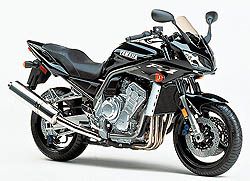
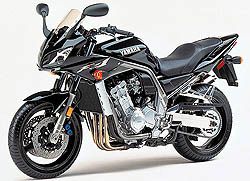
[] IowaZ Sitemap []
Send Email [] FZ1
Owner's Association [] IowaZ
Vmax Sitemap [] IowaZ
V65 Magna Page []
Any reproduction of this site or it's contents requires express written consent.
|
To Open a Search or Find-a-Word Window, press "Ctrl" and "F" at the same time. |